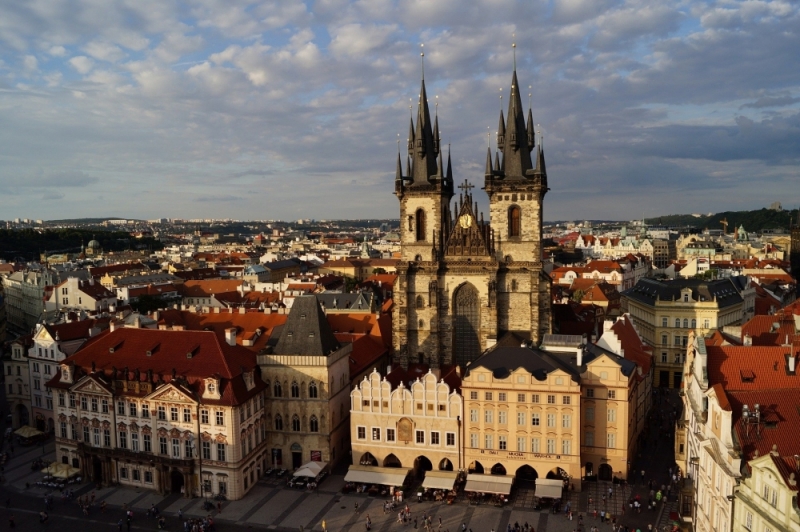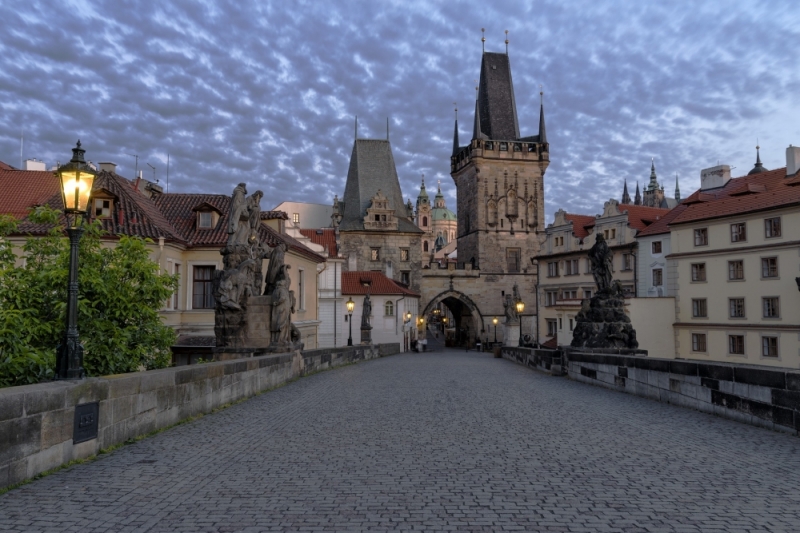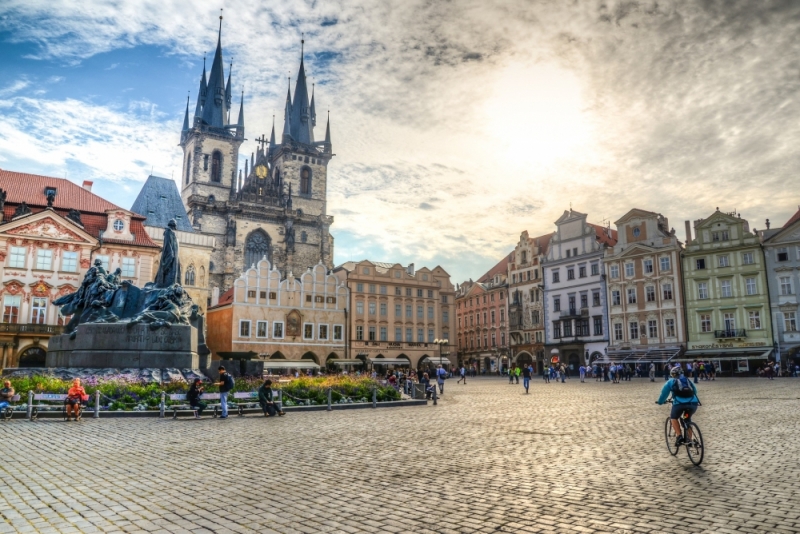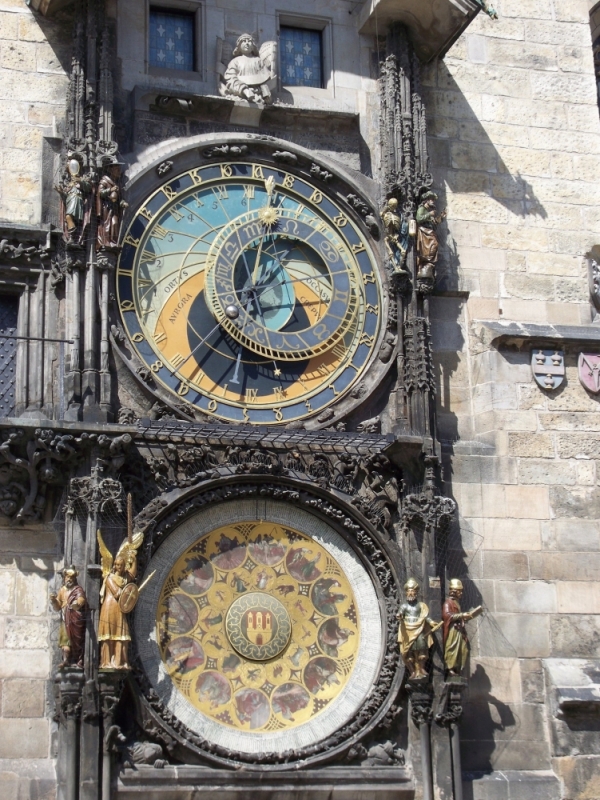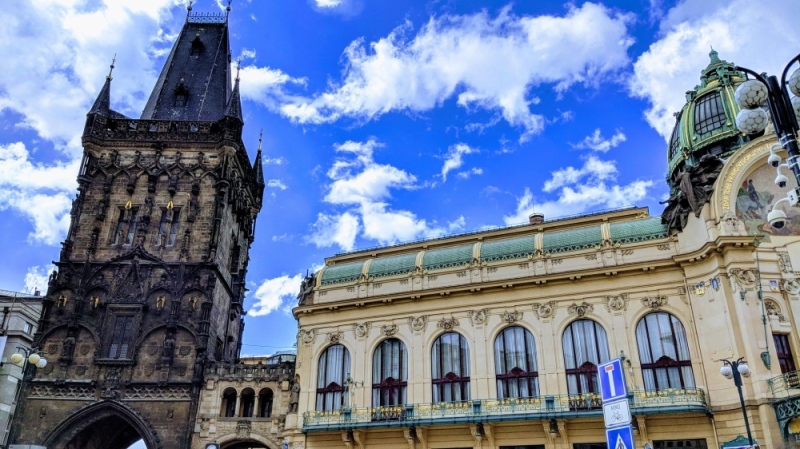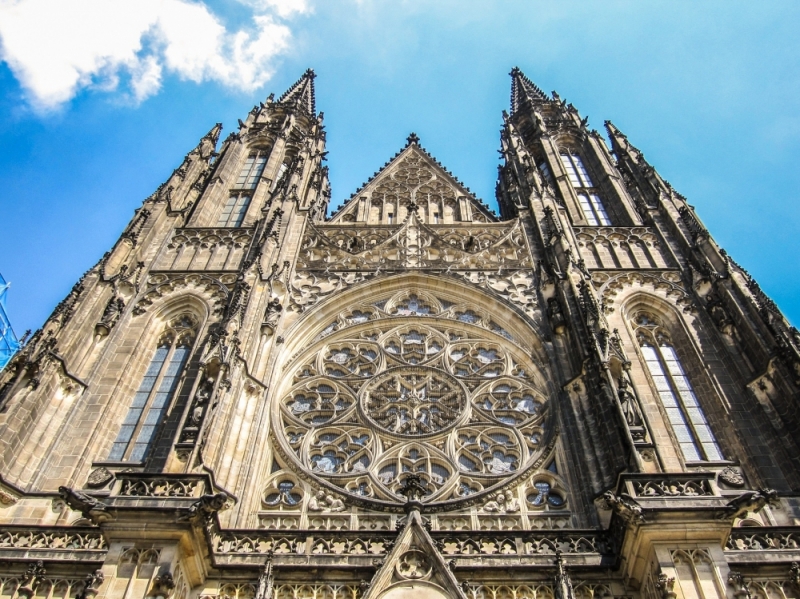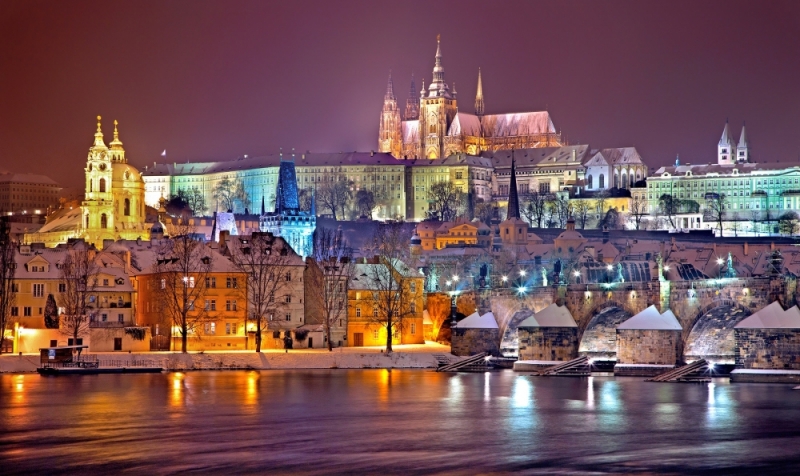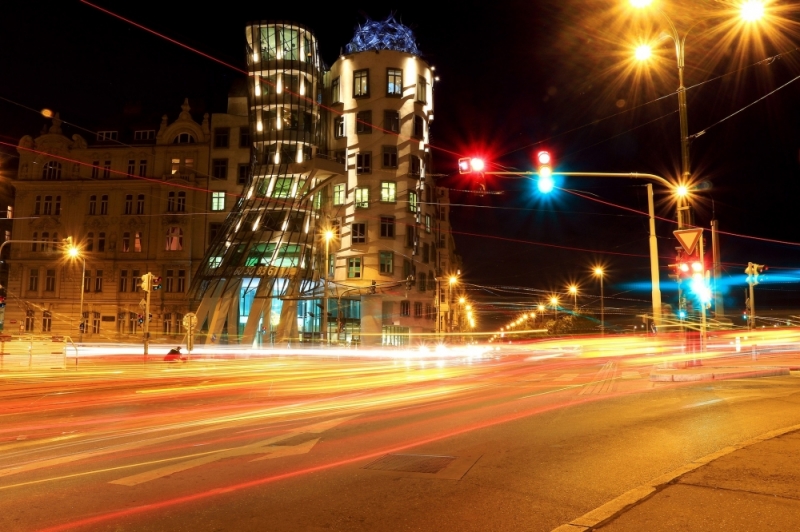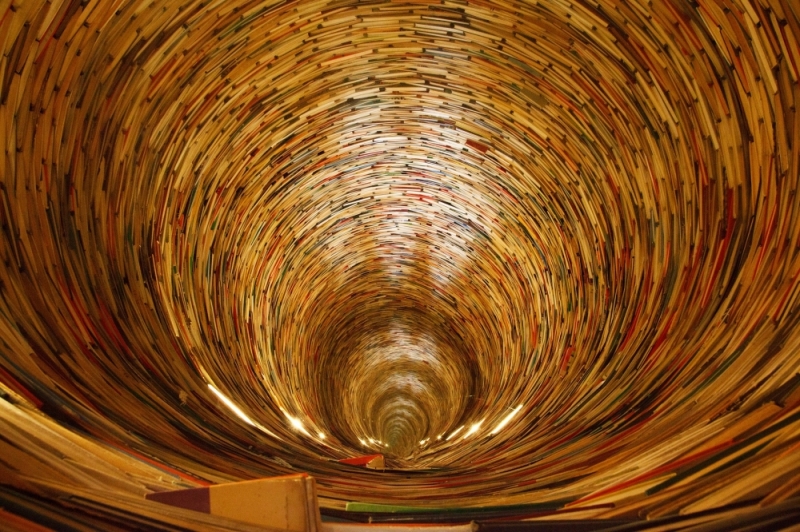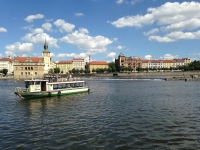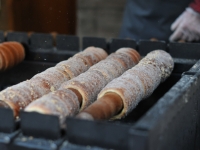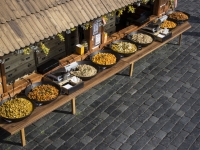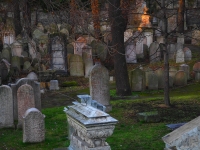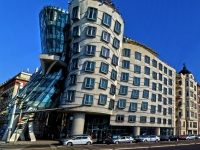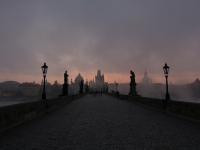Prague and its origins
Prague is the capital of the Czech Republic. Homeland of important artists, such as Franz Kafka and Milan Kundera, Prague is located on the banks of the Vltava River, the river that divides the city into Stare Mesto (old town) and Nove Mesto (new town). Prague seems like something out of a fairy tale, it has an overwhelming magic, as if it takes you back in time, covering its thousand years of history. Yes, because Prague today is a thriving city, which has opened its doors to tourists from all over the world, but it is a very ancient city, just think that the first Prague castle, the Vyšehrad, dates back to the 9th century. According to legend, Prague was founded by Princess Libuše, who predicted the greatness of Prague, and by her husband Přemys, a peasant who, having become king for displacing Libuše, started the dynasty that would reign over Prague and the then Bohemia , for 400 years.
The Přemyslidi dynasty reigned in Bohemia for 400 years, until the assassination of King Wenceslas III, killed because of his inadequacy to reign.
During this dynasty, there were many rulers who, apart from the right bank, where Vyšehrad castle was located, also extended on the left bank, in fact, King Vladislaus had the first bridge built, the Judith Bridge, which later became, after a reconstruction, the famous Charles Bridge that you can still travel today. The Charles Bridge owes its name to Charles IV, king of Bohemia and Emperor of the Holy Roman Empire, who made Prague the capital. With Charles IV, Prague experienced a period of great splendor and development. The emperor had Nove Mesto, a new city, built on the other side of the river. In this part of the city, known as Mala Strana, a number of important buildings were built, such as Prague Castle, St. Vitus Cathedral and the Carolina University.
What see
Prague is a small city, different from the capitals of western Europe. Its historic center is a magical place, full of legends that describe the origins of the city. Legendary, for example, is the Charles Bridge, which divides the city in two: on one side Stare Mesto, the old city and on the other Nove Mesto, the new city where there is the Malà Strana district which is an architectural jewel left intact over the centuries.
Charles Bridge began to be built in 1357, at the behest of Charles IV. In addition to the statues that line it, there are 3 towers guarding the bridge, two on the side of Nove Mesto and one on the side of Stare Mesto. Legend has it that the statues on the bridge come to life at night.
Astronomic watch
Stare Mesto is rich in historical buildings, civil and otherwise. Surely, the most famous building is the Town Hall with the Astronomical Clock tower, built in 1410, which, thanks to a secret mechanism, which every hour, from 9 to 23, comes to life and
Powder Gate and Wenceslas Square
Turning through the streets of Stare Mesto, you will surely pass under the Powder Gate , one of the 13 gates of Prague, which was the gateway to the old city. From here began the Royal road through which the procession for the coronation of the Bohemian Kings passed, to the Prague Castle. The gate owes its name to the fact that its tower, which can also be visited, served as a warehouse for gunpowder.
After passing the door, you will find yourself in Republic Square (náměstí Republiky) characterized by beautiful buildings built between the nineteenth and twentieth centuries, such as the Municipal House of Prague, a beautiful Art Nouveau building.
If, on the other hand, you go to the opposite side of the Republic Square, you will arrive in another famous Prague square, Wenceslas Square.
Wenceslas Square is a very characteristic square, given its shape, which develops in length rather than in width, in fact the square is only 60 meters wide but is 750 meters long. This is one of the most important squares for the Prague people and for the whole Czech Republic, as it is here that the so-called Prague Spring began, a historical period during which the Czech Republic and the Slovak Republic managed to gain independence from the Union. Soviet, thus becoming the Czechoslovak Republic. Symbol of the anti-Soviet resistance was Jan Palach, a young Czechoslovak who, to demonstrate against the Soviets, together with his other university friends, sprinkled with petrol and set himself on fire in Wenceslas Square, in front of the headquarters of the National Museum . Jan Palach has become a symbol for the Czech Republic, so much so that in Wenceslas Square, precisely at the exact point where he committed suicide, President Havel in 1990 had a plaque installed in memory of his sacrifice. If you pass there, you will certainly find young people praying or carrying flowers on the tombstone.
After passing the door, you will find yourself in Republic Square (náměstí Republiky) characterized by beautiful buildings built between the nineteenth and twentieth centuries, such as the Municipal House of Prague, a beautiful Art Nouveau building.
If, on the other hand, you go to the opposite side of the Republic Square, you will arrive in another famous Prague square, Wenceslas Square.
Wenceslas Square is a very characteristic square, given its shape, which develops in length rather than in width, in fact the square is only 60 meters wide but is 750 meters long. This is one of the most important squares for the Prague people and for the whole Czech Republic, as it is here that the so-called Prague Spring began, a historical period during which the Czech Republic and the Slovak Republic managed to gain independence from the Union. Soviet, thus becoming the Czechoslovak Republic. Symbol of the anti-Soviet resistance was Jan Palach, a young Czechoslovak who, to demonstrate against the Soviets, together with his other university friends, sprinkled with petrol and set himself on fire in Wenceslas Square, in front of the headquarters of the National Museum . Jan Palach has become a symbol for the Czech Republic, so much so that in Wenceslas Square, precisely at the exact point where he committed suicide, President Havel in 1990 had a plaque installed in memory of his sacrifice. If you pass there, you will certainly find young people praying or carrying flowers on the tombstone.
Mala strana e Nerudova
Meanwhile, if you decide to cross the Charles Bridge , you will find yourself in the magical district of Mala Strana from which Nove Mesto , the new city, begins. Once you get off the Charles Bridge, you will find yourself in the heart of Mala Strana, or its Malostranske Namesti , a square surrounded by beautiful Baroque buildings. Once you arrive in the square, we advise you to enter the Church of San Nicola , which separates the upper part of the square from the lower one. The church of San Nicola (not to be confused with that of Stare Mesto) is a masterpiece of the so-called Prague Baroque. Before going to Mala Strana and heading to the Castle, we advise you to take a detour and pass in front of the "Lennon Wall" , a wall on which murals inspired by the songs of Lennone and the Beatles have been painted, symbols of peace, love and brotherhood, becoming a monument to these values. Once you reach the wall, you will surely find some boy who leaves his signature or some street artist who sings songs full of meaning. Returning to the square, from here begins one of the most important streets in Prague, the Nerudova , an uphill road, which will take you from the square of Mala Strana to the Prague Castle . The climb is a bit tiring to do, but along the way you will surely find refreshment points and bars where you can stop to catch your breath. A peculiarity of Nerudova, are the house numbers: before they were introduced, the houses and palaces of this very famous street, were distinguished by particular signs, which represented different subjects, such as the famous 3 violins, the black lion or the key of 'gold. Look for them all, it will be really fun.
Prague Castle - St. Vitus Cathedral
To visit Prague Castle will take almost a whole day, that's why we left it last, so that you could have seen everything before dedicating yourself exclusively to visiting the largest castle in the world. It was the seat of the Bohemian Kings and in 1918 it became the seat of the President of the Czech Republic. You will realize that you have arrived at the entrance of the castle when you find yourself in front of the Matthias Gate , a majestic Baroque style door, to whose on the sides there are two guards. In front of this door, the changing of the guard is held every hour, a ceremony full of folklore, which has nothing to envy to the most famous changing of the London guard. The door gives access to the first courtyard of the Castle. But the real tour starts from the third courtyard, where you will find some of the most beautiful buildings. Yes, because the Castle does not appear as a single block, it is rather a set of buildings, including the beautiful Cathedral of San Vito , the Convent of San Giorgio and the Ancient Royal Palace. Entering the third courtyard, you will find yourself, in fact, in front of the Cathedral of San Vito, one of the most symbolic places in the city. In the Cathedral you will find important relics, such as the head of the Evangelist Saint Luke, the tomb of Wenceslaus IV, called the Good King and, in the Crown Room , there are the jewels of the Crown of the Bohemian King. This room is obviously forbidden to the public and can only be opened with 7 keys which are kept by 7 important state personalities such as, for example, the President of the Republic.
Prague Castle part two
After passing the Cathedral, you will then arrive at the entrance of the actual Royal Palace . Entering the Palace, you will find yourself in the majestic Vladislao Hall , a room so large that horse games were once held there. The Hall is characterized by large Renaissance-style windows and is now used for the election of the President of the Czech Republic. From the Vladislao Hall you enter the Ludvik wing, famous because it is here that the defenestation of Prague took place, in 1618, when the Protestants threw the Catholic governors out the window and started the Thirty Years War. Other very beautiful buildings to visit, inside the Castle Complex, are the Convent and the Basilica of San Giorgio . Inside the Convent there is the National Gallery of Bohemian Art, while the Basilica instead is a beautiful example of Romanesque style. Walking through the narrow streets inside the castle, you will find yourself, at a certain point, entering the legendary Golden Lane , between low and colorful houses, which give a particular charm to this alley. This path was wanted by King Rudolph II, an alchemy enthusiast, who invited scholars from all over Europe to move there to take care of alchemy at his court. But the name Vicolo d'oro is due to the many goldsmiths who lived here since 1600. During the First World War, Kafka also moved there. In fact, at No. 22 you will find his house museum. It is a small blue house where today there is a shop selling the books of the famous writer.
The Jewish Ghetto
Josefov was one of the oldest Jewish ghettos in Europe as it seems that the first Jews arrived in Prague as early as the tenth century. Today, the now former ghetto is an integral part of Prague, characterized by Liberty-style buildings and luxury boutiques, behind which lies the sad story of the Jews of Prague, characterized, in fact, by ghettoization, violence and extermination later deportation to concentration camps during World War II. In fact, until the renovation that took place in 1800, the buildings that can be seen today were nothing but cramped and rough constructions, the streets, instead of being the wide avenues today, were tiny streets. Franz Kafka was born here, near Stare Mesto, on July 3, 1883, at number 3 of Namesti Franze Kafky . In 1781 King Joseph II, from whom the name of the ghetto (JOSEFOV) derives, eliminated the segregation and started a restructuring of the ghetto, giving it its current appearance. But then, in the 1900s, with the arrival of the German Nazis and the Second World War, the Jewish ghetto ceased to exist as the whole of the Prague Jewish population was deported to concentration camps and was massacred by the Nazis. In the Ghetto, you will find the ancient Jewish cemetery , where more than 100,000 Jews are believed to be buried on about 9 layers of different burials. Franz Kafka is also buried here. There are many synagogues that you can visit: there is the Old-New Synagogue , but also the Spanish Synagogue , in a characteristic Moorish style. Although, in our opinion, the most beautiful is the Jubilee Synagogue, also known as the Jerusalem Synagogue. A curiosity is that according to some eggends, in the Old-New Synagogue, more precisely in his attic, Rabbi Judah Loew, who lived in the second half of the 1500s, hid his GOLEM, a clay giant, shaped by the mud of the Vltava river.
Movida and entertainment
Even if you think that with the cold, in the evening, there is no nightlife, know that you are wrong. Of course, you won't find people in the square (but even on this I would have some doubts), but surely you will find many people in the premises of the Czech capital. Considering that in Prague beer costs 1 €, think how many people go out just to drink excellent beer. Gambrinus, Staropramen and Pilsner Urquell are among the best known, which you can find in all the clubs. The Prague Beer Museum is a bar / museum inside which, in addition to being able to taste 30 different types of beers, you can also discover how beer is made in the Czech Republic. Even the discos in Prague are very beautiful. In Prague there is the Duplex , one of the most famous discos in the world. But if you want, Prague offers quieter alternatives: for those who prefer it, on the Vltava river, there are the boats that, in addition to making the tour on the river, to enjoy the view of the city from the river, in the evening, will also allow you to to have romantic dinners on board. Prague is also famous for Jazz music , in fact there is no shortage in small towns that offer live jazz music. If you love theater, another experience to live in Prague is the black theater , so called because the performances take place on black backdrops with violet lights, where mimes perform in dances and music, creating truly amazing scenographic effects.
Finally, Prague is also famous for the presence of many night clubs for adults only, where it is possible to attend ballet shows, with and without streep tease. The Darling Cabaret is one of the most famous and included in the price will also provide limousine service.
Climate, curiosity and advice
Climate: Prague's climate is continental, with cold winters and mild summers. In the autumn, starting in October, the days turn gray, with frequent rains, which turn into snow already from the end of November. In winter, the temperature can often drop below freezing and snowfalls are frequent, albeit light. Given the cold air that comes from Siberia, frosts can occur. Spring is unstable and is characterized by days that can still have low temperatures and night frosts. Spring is also the rainiest season and, especially between March and April, the rains can turn into snowfall. Without any doubt, summer is the best season to visit Prague as it is characterized by hot but not sultry days. In July and August, the hottest months, temperatures can reach around 22-24 ° and rarely exceed 30 °.
Curiosity: You will surely know it, but we want to report it on our site anyway, that in Prague there are two wonderful buildings, which house the headquarters of the Dutch National Offices. These buildings, better known as the Dancing House, are one of the many "monuments" of Prague, which attract many tourists. The Dancing House is also known as "Fred and Ginger" (from Fred Astaire and Ginger Rogers), precisely because they remember a couple of dancers. The optical effect that is created when looking at it when in front of it, gives the impression that the house actually dances. Furthermore, another peculiarity is that, despite being occupied by offices, on the 7th floor of the building, there is a French restaurant, from which you can enjoy a beautiful view of Prague. Another interesting curiosity is that, if you find yourself visiting the Municipal Library of Prague, you will manage to have a sense of infinity. This is because, inside the library, there is a tunnel of books. The peculiarity of the tunnel is given by the fact that, partially entering from the side opening of the tunnel, you can photograph the infinite, since at the top of the tunnel there are two mirrors, which, precisely, create an optical effect, such as to make it seems that the tunnel is infinite. Don't miss it, among other things, admission to the library is free.
Tips: The Czech Republic is not part of the Euro, which means that once you get there you will have to change your Euros, Dollars, Pounds, etc. in Czech crowns. The thing we advise you to do is not to absolutely change your money at the airport, but to do it in the city, as the commissions are much lower.


